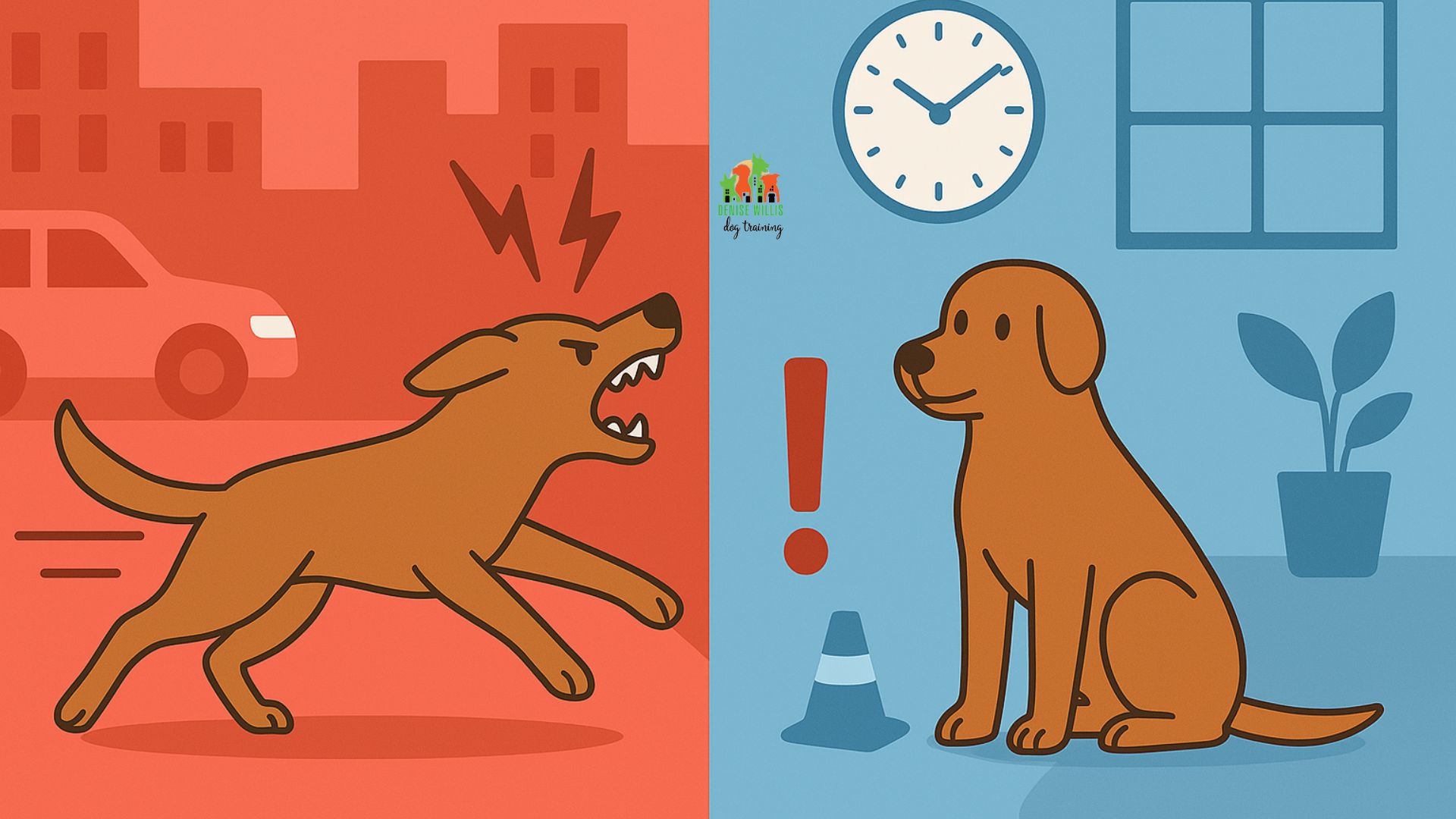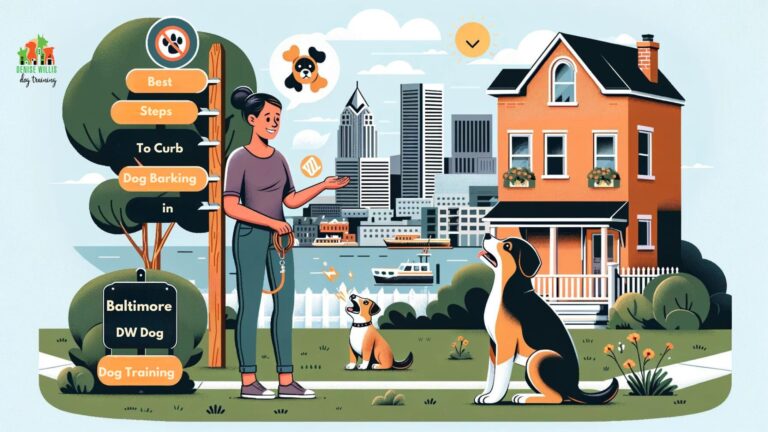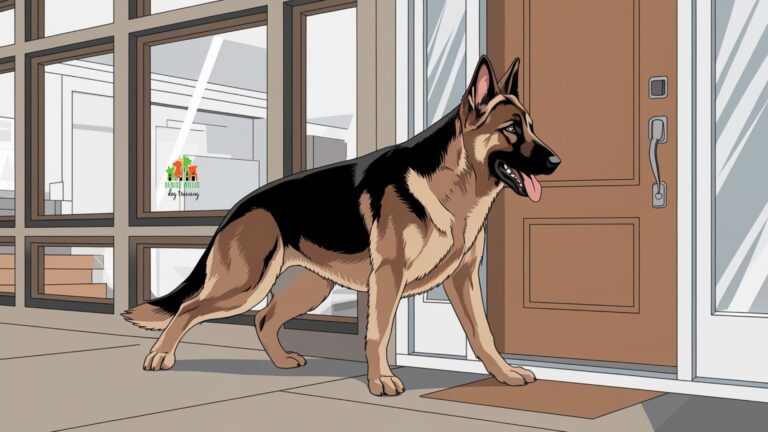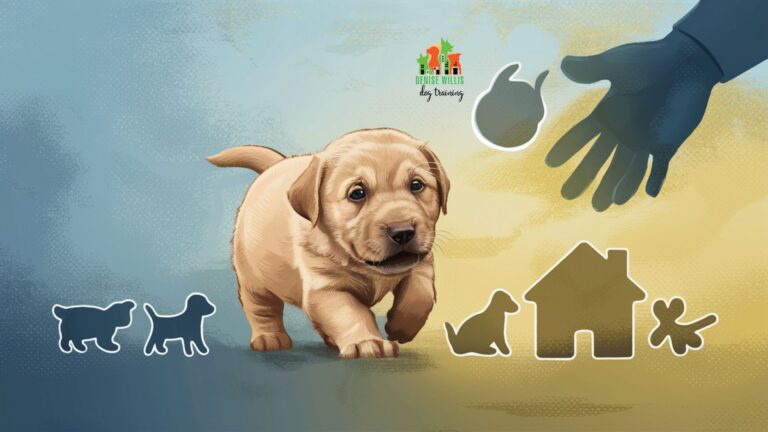Order in the Pack: How Structure Reduces Dog Aggression
📍 Service Area Notice: DW Dog Training provides in-person training services exclusively in the Greater Baltimore area. While our blog content is designed to help dog owners internationally, our hands-on training services are locally focused. For readers outside our service area, we hope you find value in our articles and welcome you to reach out with questions!
That moment when your normally sweet pup transforms into a snarling, lunging beast at the sight of another dog can turn a pleasant walk into a nightmare faster than you can say “drop the leash.” If you’ve ever found yourself apologizing profusely while wrestling your furry Jekyll and Hyde away from a trigger, you’re not alone. Dog aggression affects countless owners, leaving them feeling helpless, embarrassed, and sometimes even afraid of their own four-legged family members.
But here’s the good news that many frustrated dog parents don’t realize: Structure and dog aggression are intimately connected, and understanding this relationship could be the key to transforming your canine companion from reactive to relaxed. Like children who act out when boundaries are unclear, dogs often display aggression when they lack the security that comes from consistent structure.
The kitchen of modern dog training has moved beyond the old “alpha roll” recipes of yesteryear. Today’s approach is less about dominating your dog and more about creating an environment where they feel secure enough not to resort to aggressive displays. By implementing proper structure, you’re essentially giving your dog the canine equivalent of a reliable GPS system, clear directions that help them navigate a world that can otherwise feel overwhelming.
Key Takeaways
- Structure provides consistency and predictability that significantly reduces anxiety-driven aggression
- Clear boundaries establish leadership that prevents dominance-related aggression
- Regular routines help manage stress triggers that lead to reactive aggression
- Environmental management combined with structured training creates comprehensive behavior modification
- Consistency is crucial for long-term success in managing aggressive behaviors
- Early socialization within a structured framework helps prevent aggression from developing
- Mental and physical stimulation are essential components of a structured approach to aggression
Keys to Structure for Managing Dog Aggression
Consistency & Routine
Regular schedules for meals, walks, and training reduce anxiety and create predictable patterns that help aggressive dogs feel secure and understand expectations.
Structured Training
Positive reinforcement combined with clear boundaries teaches dogs appropriate responses to triggers, replacing aggressive behaviors with calm alternatives.
Environmental Management
Creating safe spaces, managing trigger exposure, and setting up controlled environments prevents rehearsal of aggressive behaviors while training progresses.
Physical & Mental Exercise
Appropriate exercise and mental stimulation release tension-reducing endorphins while depleting energy reserves that often fuel aggressive outbursts.
Understanding Dog Aggression
Imagine one minute you’re enjoying a peaceful stroll with your furry best friend, and the next, they’ve morphed into something resembling a four-legged tornado with teeth.
We’ve all been there.
That moment when your sweet snuggle buddy decides the neighbor’s poodle is public enemy number one.
But before you resign yourself to walking your dog at 3 AM to avoid all living creatures, let’s unpack what’s really happening in that adorably complicated canine brain. Your dog isn’t plotting world domination or harboring a secret vendetta against mail carriers (well, maybe a little). They’re actually speaking the only language they know when feeling threatened, uncomfortable, or confused.
Dog aggression is less like a character flaw and more like that friend who gets hangry. There’s almost always a logical explanation behind the drama. Modern research has identified three neurological highways to Growl Town: defensive aggression (think of your dog as a furry security guard who’s a bit too zealous about the job), proactive aggression (the canine equivalent of “this is MINE and you can’t have it”), and predatory aggression (when your domesticated wolf remembers they’re, well, descended from wolves) as explained by canine behavior experts in their analysis of canine aggressive behavior.
Before your pooch goes full Cujo, they’ll usually give you a series of hints that would make a Vegas poker player proud. These warning signals form what trainers affectionately call the “ladder of aggression,” starting with subtle tells like excessive yawning or whale eye (that sideways glance that shows the whites of their eyes) before escalating to the more obvious growls and air snaps. Learning to read these early warning signs is like getting the answer key to a test – invaluable for avoiding full-blown aggressive episodes.
Common triggers for canine aggression include fear (the “I’m scared so I’ll act scary” paradox), resource guarding (the doggy version of not sharing toys in kindergarten), territorial defense (the “get off my lawn” syndrome), pain (because we’re all grumpy when we hurt), and social conflict (some dogs just didn’t get the memo about playing nice with others). Contrary to popular belief, most aggressive displays stem from insecurity rather than some diabolical plot to rule the household. Your dog isn’t channeling Machiavelli; they’re more like that socially awkward person who stands too close at parties because they don’t know what else to do.
As behavioral veterinarians note, “While most people recognize growling or baring teeth as signs of aggression, there are actually many subtle precursors that go unnoticed,” according to a comprehensive guide to canine aggression. Think of these early signals as your dog’s way of saying, “Excuse me, I’m uncomfortable,” before they resort to shouting.
The Foundation of Structure in Dog Training
When someone suggests adding more “structure” to your dog’s life, you might envision transforming your living room into a military academy where fun goes to die and spontaneity is banned forever. Rest assured, we’re not suggesting your pup needs to start making their bed with hospital corners or standing at attention before meals.
In reality, adding structure to your dog’s life is less boot camp and more like providing them with the rules to a board game they’ve been trying to play blindfolded. Imagine being dropped into the middle of a Monopoly game with no idea what the colored squares mean, why people keep handing you funny money, or why everyone’s suddenly angry when you eat the little metal dog. That’s how many dogs feel navigating a human world without clear guidelines.
Structure essentially means creating a consistent, predictable world where your dog can confidently answer the question, “What should I do now?” It’s about establishing boundaries that transform the chaotic jumble of human behaviors, schedules, and expectations into a comprehensible pattern. Dogs find this incredibly reassuring, like how you feel when you finally get clear directions after being lost for hours.
The science behind why dogs crave structure is fascinating and a bit humbling. Despite wearing cute sweaters and having Instagram accounts, our domesticated companions still retain core psychological needs from their evolutionary past. They’re hardwired for social structures with clear communication patterns, consistent rules, and reliable expectations. When these elements go missing, many dogs experience the canine equivalent of existential angst, which often manifests as – you guessed it – aggressive behavior.
One stubborn myth that refuses to play dead is that providing structure means establishing yourself as the “alpha” through intimidation tactics that would make a schoolyard bully take notes. As modern canine behavior experts explain, “Research has clearly shown that the ‘pack theory’ and ‘dominance theory’ as applied to pet dogs is based on flawed studies and misconceptions about canine behavior,” from a comprehensive debunking of outdated pack theory approaches. Today’s understanding recognizes that dogs aren’t plotting Shakespearean power plays to overthrow you; they simply want clarity and security, kind of like most of us humans.
Structure is radically different from punishment-based methods that try to suppress unwanted behaviors through fear or intimidation. While punishment might temporarily quiet the symptoms (like taking aspirin for a broken arm), structure addresses the underlying causes by teaching dogs what they should do rather than just what they shouldn’t. It’s proactive rather than reactive, like installing guardrails instead of ambulances at the bottom of a cliff.
As our dog training expert, Denise Willis, puts it, “Structure isn’t about controlling your dog’s every move; it’s about providing a framework within which they can make good choices and feel secure,” according to our approach to canine behavior modification. Think of it as the difference between micromanaging employees and providing them with clear expectations and the tools they need to succeed. When dogs understand what’s expected of them, they’re less likely to resort to the canine equivalent of flipping tables and storming out of meetings.
The Numbers Behind the Barks: Revealing Dog Aggression Statistics
If you’ve ever wondered whether your dog’s snarling standoff with the vacuum cleaner is just a personal vendetta or part of a wider canine conspiracy, you’re not alone. The data behind dog aggression paints a fascinating picture that might just make you look at your furry friend’s occasional outbursts in a whole new light. While statistics might seem dry compared to the dramatic displays of your pooch lunging at the mailman, these numbers tell a compelling story about why structure is so critical in addressing aggressive behaviors.
Think of these statistics as the canine equivalent of those embarrassing childhood photos your parents break out at dinner parties – slightly uncomfortable to acknowledge but incredibly revealing about the bigger picture. From the surprising correlation between single-dog households and increased owner-directed aggression to the sobering reality of breed-specific incident rates, these figures help us understand the scope and patterns behind problematic behaviors.
| Statistic Type | Percentage/Number | Notes | Source |
|---|---|---|---|
| Annual Dog Bites (US) | 4.5 million | Over 800,000 require medical attention | [1] |
| Child Victims | 50%+ | Children make up the majority of dog bite victims | [1] |
| Fearfulness Impact | High Correlation | Fear is strongly associated with increased aggression toward unfamiliar people | [3] |
| Single-Dog Household Risk | Higher | Dogs in single-dog households show increased aggression toward owners versus multi-dog homes | [2] |
| Impact of Structure | Significant | Consistent routines and structured training create a calmer environment for behavior modification | [23] |
| Environmental Management Success | Critical Component | Setting up proper environmental controls significantly improves aggression behavior modification | [22] |
| Breed-Specific Fatal Attacks | 65.6% (Pit Bulls) | Pit Bulls are responsible for majority of fatal dog attacks, with Rottweilers at 10.4% | [6] |
These numbers aren’t just abstract data points floating in research journals; they’re the collected experiences of millions of dogs and their humans navigating the complex dance of coexistence. Like realizing that your “unique” parenting challenges are actually textbook examples in child development, understanding the statistical patterns behind aggression can be both reassuring (you’re not alone!) and empowering (there are proven approaches to help!).
The most important takeaway from this data?
Structure isn’t just a nice-to-have training philosophy.
It’s a statistically validated approach to reducing the very real risks associated with canine aggression. When we recognize that fear, inconsistency, and environmental triggers are measurable contributors to aggressive episodes, we can address these factors systematically rather than throwing random training techniques at the wall and hoping something sticks. That’s the difference between being a well-meaning dog parent and becoming a truly effective canine leader.
Consistency and Routine: The Cornerstones of Structure
Remember how, as a kid, snow days felt like winning a mini lottery?
That unexpected break from routine probably had you bouncing off the walls with excitement. For your dog, though, surprise schedule changes aren’t so much “snow day” as they are “what fresh chaos is this?” While we humans often crave variety, our canine companions are more like that friend who orders the same meal at every restaurant – they find profound comfort in knowing exactly what’s coming next.
Establishing predictable daily schedules for your dog isn’t just a convenient way to organize your life; it’s like installing emotional stabilizers in your pup’s world. When dogs know that breakfast happens after the morning potty break, walks occur at 5 PM, and training sessions follow dinner, they spend less mental energy worrying and more time relaxing. They can finally stop checking their imaginary watches and just enjoy being a dog.
This predictability becomes especially crucial for senior dogs, who, much like your grandpa who complains when the grocery store rearranges the cereal aisle, find change increasingly stressful as they age. Research shows that familiar routines significantly help alleviate anxiety and aggression in older dogs as highlighted by senior dog specialists. It’s like giving them a comforting roadmap through their golden years.
Consistency isn’t just about timing; it extends to rules and boundaries as well. If your dog gets scolded for jumping on guests on Friday but receives belly rubs for the same behavior on Saturday, you’re essentially creating the canine version of playing the lottery.
Sometimes they win, sometimes they lose, but they’ll keep trying because occasionally it pays off. This inconsistency breeds confusion, and confusion frequently manifests as anxiety, which can trigger aggressive responses faster than you can say “Who’s a good boy?”
The science connecting routine to reduced stress in dogs is compelling. When their days follow predictable patterns, dogs experience measurable decreases in cortisol, the body’s primary stress hormone. As canine behavior research shows, “Routine provides dogs with a sense of security and helps them understand their place in the household,” from analysis of routine’s importance in canine well-being. It’s like how you probably sleep better in your own bed.
Familiarity breeds contentment.
Real-world examples of effective routines don’t have to be complicated. They might include:
- Morning walks before breakfast (because nobody likes exercising on a full stomach, not even dogs)
- Scheduled feeding times approximately 12 hours apart (turning you into a reliable biological clock for your pup)
- Dedicated training sessions that happen at similar times each day (your dog’s version of regularly scheduled programming)
- Consistent play periods with clear beginning and ending signals (because even fun needs boundaries)
- Bedtime routines that signal the end of the day (the canine equivalent of putting on pajamas and brushing teeth)
As canine rehabilitation specialists emphasize, “The key to reducing aggression through routine is absolute consistency. Dogs thrive when they can predict what comes next in their day,” from a comprehensive guide to rehabilitation techniques for aggressive dogs. This consistency creates a framework of security that counters the uncertainty, triggering many aggressive responses.
When implementing routines, remember that the goal isn’t to create a robotic existence where spontaneity goes to die. You’re aiming for enough predictability that your dog feels secure, not so much structure that life loses all joy. Think of it as creating a reliable rhythm rather than a militaristic regimen. Within that secure framework, there’s still plenty of room for impromptu play sessions, surprise adventures, and all the joy that makes life with dogs so wonderful.
Structured Training Methods for Managing Aggression
If dog aggression were a house fire, structured training methods would be your personal fire department, complete with expertise, equipment, and a much better success rate than your panic-induced bucket brigade. While outdated approaches might have involved harsh corrections (essentially putting a lid on a boiling pot and hoping for the best), modern training recognizes that turning down the heat produces much better long-term results than just containing the steam.
At the heart of effective aggression management sits positive reinforcement, the training equivalent of catching flies with honey instead of vinegar. This approach focuses on rewarding behaviors you want to see more of rather than punishing those you’d like to see disappear. For aggressive dogs, this might mean becoming a treat-dispensing machine whenever they remain calm around triggers, creating a new equation in their minds: potential threat + calm behavior = amazing rewards.
Studies consistently show that positive reinforcement builds trust and strengthens the bond between dogs and owners, creating an emotional bank account you can draw from during challenging moments as demonstrated in research published by veterinary behaviorists. It’s like building a friendship through positive interactions rather than threats and intimidation – infinitely more effective and significantly less likely to result in someone getting bitten.
One particularly powerful technique combines desensitization with counterconditioning, fancy terms for “helping your dog get used to scary things while simultaneously teaching them that these things actually predict awesome stuff.” This systematic approach is like helping someone overcome a fear of flying by starting with looking at pictures of planes while eating chocolate, then gradually working up to sitting in a stationary aircraft, and eventually taking short flights – all while maintaining positive associations.
For example, if your dog transforms into Cujo at the sight of other dogs, you might start by showing them a dog from a distance where they can remain calm, then reward that calmness with high-value treats (think steak, not dry biscuits). Over time, you gradually decrease the distance while continuing the positive reinforcement, effectively rewiring your dog’s emotional circuitry from “other dog = danger” to “other dog = delicious treats appear.”
As professional trainers explain, “Gradual exposure to stimuli that trigger aggression, under controlled conditions, helps your dog learn to manage their reactions to triggers, reducing aggressive behaviors over time,” from a guide to overcoming canine aggression. This methodical approach is like updating your dog’s internal software, replacing the “attack.exe” program with “remain-calm-and-get-rewarded.exe.”
Building trust through structured obedience work forms another cornerstone of aggression management. Basic commands like “sit,” “stay,” and “leave it” aren’t just party tricks; they’re communication tools that give you a way to guide your dog through potentially problematic situations. More importantly, the process of learning these commands in a structured, positive way helps your dog build confidence and trust in your leadership. It’s like learning to dance with a partner. Once you establish who leads and who follows, the moves become more fluid and less likely to result in stepped-on toes.
What many people miss is that structured training isn’t just about teaching specific behaviors; it’s about changing how your dog feels about certain situations or triggers. This emotional reconditioning is the difference between a dog who doesn’t lunge because they’re afraid of punishment and one who genuinely feels relaxed in formerly triggering situations.
Canine behavior specialists note that “The goal of positive reinforcement in aggressive dog training isn’t just compliance; it’s changing the underlying emotional state that drives the aggression,” according to analysis of positive reinforcement techniques for aggressive dogs. This fundamental shift in emotional state is like helping someone overcome a phobia rather than just teaching them to white-knuckle through their fear – infinitely more effective and compassionate.
Remember that addressing aggression requires patience and consistency.
Quick fixes in dog training are about as real as crash diets that work long-term, tempting to believe in but rarely effective. With structured, positive approaches, most dogs show significant improvement over time, but the journey might be measured in months rather than days. The destination, though, a calmer, more confident dog who can navigate the world without resorting to aggression, is absolutely worth the trip.
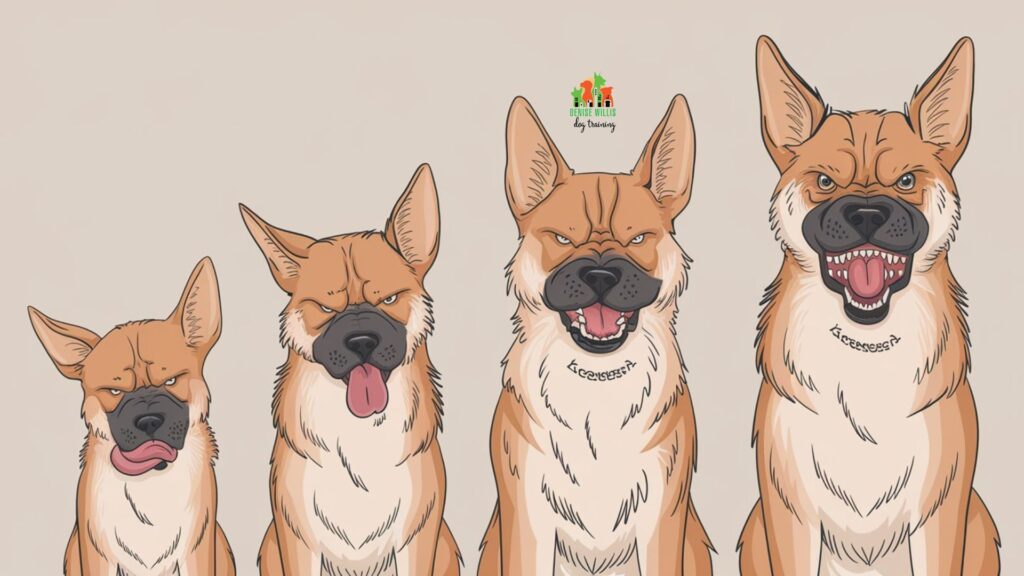
Environmental Management Strategies
Let’s face it.
Expecting an aggressive dog to handle every situation flawlessly is like asking a toddler to navigate a candy store without touching anything. Sometimes, the smartest approach isn’t training through a trigger but avoiding it altogether. Welcome to the world of environmental management, where strategic planning beats heroic training attempts every time.
Creating safe spaces tops the list of effective management strategies. Every dog deserves their own canine equivalent of a man cave or she shed, a place where they can retreat when the world becomes too much. This might be a comfy crate decorated like a doggy penthouse suite, a specific room, or even just a designated bed in a quiet corner. These sanctuaries aren’t punishment zones but rather stress-free retreats where your pup can decompress without worrying about defending themselves.
As canine behavior specialists note, “A properly introduced safe space can dramatically reduce aggressive incidents by giving anxious dogs an alternative to confrontation,” according to research on environmental modifications for aggressive dogs. Think of it as creating an emotional emergency exit for your dog, much more preferable than them choosing fight over flight.
Managing access to trigger situations forms another crucial pillar of environmental management. If your dog transforms into a whirling dervish of teeth and fury when the mail carrier arrives, scheduling training sessions during non-delivery hours makes infinitely more sense than repeatedly creating showdowns at high noon. Similarly, if dog parks send your pup into a tailspin of aggression, finding alternative exercise venues prevents practicing problematic behaviors while you work through training.
Using management tools effectively can make the difference between peaceful coexistence and constant stress. Baby gates, exercise pens, basket muzzles (the comfortable kind that allow panting, drinking, and treating), head halters, and properly fitted harnesses aren’t admissions of failure but rather smart tools in your aggression-management toolbox. Just as you wouldn’t consider it cheating to use a hammer rather than your bare hand to drive a nail, using appropriate equipment to manage aggression is simply intelligent problem-solving.
“Environmental management isn’t about avoiding training; it’s about preventing rehearsal of unwanted behaviors while training solutions are implemented,” explains our training team at DW Dog Training based on our approach to managing aggressive dogs. Think of it as putting training wheels on a bike, not a permanent solution but a way to prevent crashes while more substantial skills develop.
Modifying the home environment to reduce overall stress levels often produces surprising improvements in aggressive behaviors. Simple changes like providing visual barriers around windows where your dog fence-fights with neighborhood dogs, creating consistent resting spots for each pet in multi-dog households, or establishing feeding stations that prevent resource guarding can dramatically reduce day-to-day tension. It’s the canine equivalent of soundproofing your home office, creating a space where concentration becomes possible instead of constantly battling distractions.
Remember that environmental management isn’t an admission of defeat but rather a recognition that some situations exceed your dog’s current emotional capacity. Even the best-trained dogs have their limits, just like even Olympic swimmers occasionally need life jackets in rough seas. By controlling the environment, you’re not giving up on training; you’re creating the conditions where learning becomes possible.
The Role of Exercise and Mental Stimulation
If you’ve ever been stuck in a tiny airplane seat for a 10-hour flight, you understand how pent-up energy can make anyone cranky and reactive. Now imagine being a dog, literally built for movement and activity, confined to a house or yard for days with nothing but brief potty breaks. Suddenly, their snippy attitude makes perfect sense, doesn’t it?
Physical exercise represents one of the most overlooked yet powerful tools for reducing aggressive behaviors. A properly exercised dog has burned off the fizzy energy that often fuels reactivity, leaving them in a calmer, more receptive state for training and daily life. As one canine fitness expert puts it, “A tired dog is a good dog isn’t just a cute saying; it’s based on the physiological reality that exercise releases tension-reducing endorphins while depleting the energy reserves that often fuel aggressive outbursts” according to research on exercise’s impact on canine behavior.
However, not all exercise is created equal. There’s a crucial difference between structured play and unstructured excitement, particularly for dogs with aggression issues. While twenty minutes of disciplined heeling or structured retrieval games can reduce aggressive tendencies, twenty minutes of frenzied tug-of-war with no rules might actually increase arousal and subsequent reactivity. It’s the difference between a yoga class and a mosh pit, both involve movement but with vastly different effects on your nervous system.
“For dogs with aggression issues, the quality of exercise matters as much as the quantity,” explains our training director at DW Dog Training, based on our work with reactive dogs. “Activities that combine physical movement with mental focus and impulse control, like structured fetch with sit-stays between throws or scent work, provide the ideal combination of physical outlet and emotional regulation.”
Mental enrichment proves equally important for reducing frustration and boredom, two common drivers of aggressive behavior. Dogs need cognitive challenges as much as they need physical outlets, particularly breeds developed for problem-solving tasks like hunting, herding, or detection work. Without adequate mental stimulation, these dogs often invent their own jobs, which might include aggressive gatekeeping or territorial behaviors.
Puzzle toys, scent games, training sessions, and guided exploration walks (where the dog gets to use their nose and make some choices within safe parameters) all provide the mental exercise many dogs desperately crave. Think of it as giving your dog the canine equivalent of a crossword puzzle rather than leaving them to write graffiti on the metaphorical walls.
Different types of dogs need different exercise regimens. Your Border Collie might require an hour of ball chasing plus training sessions to feel satisfied, while your senior Bulldog might be content with two 20-minute sniff-focused walks. The key is matching the exercise type and duration to your particular dog’s breed tendencies, age, health status, and individual personality. It’s like finding the right workout plan; the perfect one exists, but it’s not necessarily the same for everyone.
When developing an exercise plan for an aggressive dog, start with activities that keep arousal levels moderate rather than those that amp your dog up to eleven on the excitement scale. For many reactive dogs, activities like swimming, structured walking with frequent direction changes, or controlled fetch sessions provide better stress relief than dog parks or agility, which might overstimulate already reactive individuals.
Remember that a physically and mentally tired dog has fewer emotional resources available for aggressive displays. By providing appropriate exercise and enrichment, you’re not just making your dog healthier; you’re directly addressing one of the foundational contributors to aggressive behavior.
Early Intervention and Socialization
If aggression were a house fire, early socialization would be your smoke detector, sprinkler system, and fire-resistant building materials all wrapped into one. Preventing a problem is infinitely easier than fixing one, and nowhere is this more true than with dog aggression. The good news? The blueprint for prevention is clear, research-backed, and remarkably effective.
The critical periods for socialization arrive earlier than many new puppy parents realize. Between 3-14 weeks of age, puppies go through a developmental window where they’re uniquely receptive to new experiences. During this time, their brains are literally being wired to determine what’s normal versus what’s threatening in their world. It’s like programming a computer; the code written during this period creates the operating system your puppy will run for life.
“Early socialization is so powerful that research indicates over 70% of aggression cases can be linked to inadequate socialization during early development,” note canine development researchers according to comprehensive studies on preventing aggressive behaviors. Think of it as investing in your puppy’s emotional 401K. Small, consistent deposits during those early weeks yield massive dividends throughout their life.
Structured exposure to diverse environments, people, animals, and situations forms the cornerstone of effective socialization. Note the word “structured” here, which means careful, positive introductions rather than throwing your puppy into chaotic situations and hoping for the best. Quality trumps quantity every time when it comes to early experiences. Ten positive, controlled introductions to new people will build more confidence than one overwhelming visit to a crowded farmer’s market that sends your puppy into a panic.
“The goal of socialization isn’t exposure for exposure’s sake, but rather helping puppies build positive associations with the full spectrum of situations they’ll encounter in adult life,” explains our puppy development team at DW Dog Training based on our early intervention programs. This means pairing new experiences with treats, praise, play, and other good things that tell your puppy’s developing brain, “This new thing predicts awesome stuff!”
Recognizing warning signs in puppies can save years of remedial training later. While some puppyhood behaviors like playful growling during tug are perfectly normal, others merit immediate professional attention. These include:
- Freezing or growling when touched or approached while eating
- Consistent fear responses (trembling, backing away, hiding) to normal environmental stimuli
- Excessive mouthing that doesn’t respond to typical redirection
- Early resource guarding of toys, food, or sleeping locations
- Prolonged fear periods that don’t resolve with gentle exposure
These aren’t signs your puppy is “bad” but rather early indicators that they may need extra support in developing confidence and appropriate responses. It’s like noticing your child struggles with certain subjects in school, not a character flaw but an opportunity for targeted support.
For older dogs who missed critical socialization periods, all hope isn’t lost, but the approach shifts from prevention to remediation. The principles remain similar, controlled exposure beneath threshold combined with positive associations, but the process typically takes longer and requires more carefully managed steps. It’s like learning a language as an adult versus as a child, still completely possible but requiring more conscious effort.
Early intervention programs yield spectacular results, often preventing problems that would otherwise require months or years of behavior modification to address. By investing in proper socialization during those critical early weeks, you’re giving your puppy the foundation for a lifetime of confidence and appropriate social behavior.
Case Studies: Structure in Action
Theory is wonderful, but sometimes you need to see the recipe in action to believe it really works. Let’s look at some real-world success stories where structured approaches transformed aggressive dogs from neighborhood terrors to canine good citizens.
Meet Max, a three-year-old German Shepherd who had developed severe leash reactivity to other dogs. Every walk had become a nightmare of lunging, barking, and general chaos that left both Max and his owner exhausted and stressed. After implementing a structured approach that included:
- Consistent daily routine with set times for walks, meals, and training
- Structured training sessions using positive reinforcement to build focus and impulse control
- Controlled exposure to triggers at distances where Max could remain calm
- Environmental management using proper equipment and alternative walking routes
- Appropriate physical exercise and mental stimulation
Within three months, Max could pass other dogs with just a momentary look rather than his previous full-scale meltdowns. His owner reports, “The transformation wasn’t overnight, but each week brought noticeable improvements. Now I actually enjoy our walks instead of dreading them.”
Then there’s Bella, a resource-guarding Cocker Spaniel who had bitten family members over food, toys, and furniture access. Her family was at their wit’s end, considering relinquishment until they implemented an intensive structure program:
- Strictly scheduled feeding times in a separate, quiet location
- Clear rules around furniture access with designated dog beds throughout the house
- Structured trading games that taught Bella that giving up items led to even better rewards
- Consistent responses from all family members to guarding behaviors
- Daily training sessions that built impulse control and trust
Six months later, Bella showed no signs of her previous guarding behaviors. The key turned out to be the consistency and predictability that the structure provided, allowing Bella to relax instead of constantly trying to control her resources.
As documented by professional trainers working with aggression cases, “The common thread in successful rehabilitation is not the specific techniques used but rather the consistency with which they’re applied,” according to case studies of aggressive dog rehabilitation. Like physical therapy for an injury, the exercises matter, but the faithful daily implementation matters more.
Ruby, a fear-aggressive rescue who would lunge and snap at strangers, represents another success story with a slightly different approach. Her rehabilitation focused heavily on environmental management:
- Creating a “stranger danger” protocol that all visitors followed
- Establishing a safe room where Ruby could retreat during gatherings
- Structured desensitization to specific triggers like men with beards or people wearing hats
- Consistent obedience work that gave her handlers clear communication tools
Within a year, Ruby could comfortably meet new people given proper introduction protocols. She’ll never be a social butterfly, but she’s now a safe, manageable companion rather than a liability.
“The most important factor in these success stories isn’t the speed of change but the sustainability of the results,” notes our behavior team at DW Dog Training based on our case histories with aggressive dogs. Quick fixes tend to produce quick relapses, while thorough behavior modification through consistent structure creates lasting transformation.
These cases highlight a crucial truth: there’s no one-size-fits-all approach to aggression. The structure framework remains consistent, but the specific applications vary based on the individual dog, the type of aggression, and the household dynamics. The art of behavior modification lies in adapting these principles to each unique situation while maintaining the core foundation of consistency, clarity, and compassionate leadership.
Product Recommendations
Shopping for a structurally challenged, occasionally explosive canine companion is a bit like preparing for a tiny furry tornado that you happen to love unconditionally. While consistency and training form the foundation of aggression management, having the right tools in your arsenal can make the difference between a structured success story and finding yourself apologizing to yet another terrified delivery person.
We’ve rounded up some game-changing gear that might just turn your reactive rover into a model citizen, or at least reduce your stress-induced chocolate consumption.
- ThunderShirt Classic Dog Anxiety Jacket: Wrap your wound-up woofer in this snug hug simulator and watch their anxiety melt faster than ice cream at a summer picnic. Using gentle, constant pressure, it’s like a weighted blanket for your barky buddy. While it won’t solve complex aggression issues, it might just take the edge off enough for your training to sink in. Warning: Your dog may become so relaxed they develop a sudden interest in smooth jazz and herbal tea.
- PetSafe Gentle Leader Head Collar: Transform your lunging leviathan into a manageable companion with this ingenious head halter. It gives you steering control without force, allowing you to redirect attention before your dog goes full Cujo at the sight of the neighbor’s cat. Works on the same principle as a horse halter, but we don’t recommend entering your newly-compliant canine in the Kentucky Derby. Caution: Your dog may temporarily believe they’ve joined an exclusive face-accessory fashion club and expect formal invitations to doggy galas.
- KONG Classic Dog Toy: The Swiss Army knife of dog toys and a secret weapon in your structure-building toolkit. Fill it with treats, freeze it, and give your dog a constructive outlet for chewing, licking, and problem-solving instead of plotting neighborhood domination. Practically indestructible and infinitely versatile, it’s like therapy in a rubber cone. Warning: Your dog may develop such advanced problem-solving skills they start helping with your taxes and questioning your financial decisions.
- Outward Hound Nina Ottosson Dog Brick Puzzle Toy: Mental stimulation is crucial for aggressive dogs, and this interactive puzzle provides the perfect brain workout. Watching your formerly reactive rover concentrate on sliding compartments to reveal hidden treats is like witnessing a furry Einstein at work. The mental fatigue from 15 minutes with this toy often equals an hour of physical exercise. Caution: Your dog may develop such advanced cognitive abilities they start questioning why you still can’t figure out how to program the DVR.
- Zuke’s Mini Naturals Training Dog Treats: Small, soft, and lower in calories, these treats are the perfect currency for rewarding calm behavior and successful training moments. Keep them in every pocket, drawer, and secret hiding place for instant reinforcement when your dog chooses peace over chaos. These tiny taste explosions are like doggy Bitcoin, small but incredibly valuable in your training economy. Warning: Your dog may start following you everywhere with that hopeful look that suggests they’re just one adorable head tilt away from another reward.
With the right combination of tools, training, and considerable patience, your formerly reactive companion can learn to navigate the world with newfound confidence. Just remember, none of these products are magic wands, just helpful assistants in your structured training approach. Think of them as supporting actors in the Oscar-worthy performance that is rehabilitating an aggressive dog, with you and your consistency playing the lead roles.
Further Reading
Think you’ve mastered the art of structure and dog aggression? Well, we’re just getting started! Look deeper into the fascinating world of canine cognition and behavior modification with these brain-expanding articles. Side effects may include spontaneously speaking in training terminology and boring non-dog people at dinner parties.
- Consistency in Addressing Dog Aggression: Discover why your dog thrives on predictability and wilts with wishy-washy rules. This article explains how your Monday-to-Friday inconsistency might be why Fido thinks the mailman is a deadly threat but only on Tuesdays and Saturdays. Spoiler alert: Your dog isn’t confused, they’re just following the confusing blueprint you’ve provided!
- Environmental Triggers for Dog Aggression: Think your dog’s aggression appears out of nowhere? Think again! This eye-opening exploration identifies the subtle environmental factors that might be setting your pooch off faster than a firework at a cat convention. Learn to spot these triggers before your dog practices their best impression of a furry security alarm.
- 10 Warning Signs Your Dog Might Bite and How to Prevent It: Dogs rarely bite without warning, but are you fluent in canine body language or just nodding politely while your dog screams “I’m uncomfortable!” in dog? This guide decodes the secret signals your dog sends before resorting to teeth. Master these signs and you’ll suddenly appear magical to friends who can’t figure out how you “just knew” your dog was about to lose patience.
- Decoding Your Dog: 15 Body Language Signals You Need to Know: Finally, the translation guide to understanding what your dog has been trying to tell you all along! From the subtleties of ear position to the complexities of tail wagging, this article turns you into a certified dog linguist. Warning: May result in you unconsciously tilting your head when confused and wagging your behind when excited.
- Dog Aggression Solutions: A Complete Guide to Stopping Aggressive Behavior in Dogs: The ultimate playbook for tackling canine aggression from every angle. It’s like “The Art of War” meets “Dog Training for Dummies,” minus the ancient Chinese philosophy (unless your dog is particularly into Eastern thought). Whether your challenge is resource guarding or reactivity, this comprehensive guide has you covered.
Ready to graduate from casual dog owner to behavior specialist who annoys everyone at parties with unsolicited training advice?
These articles are your gateway drug to becoming that person who can’t help but critique other people’s handling techniques at the dog park. Embrace the journey, stock up on treats, and remember: behind every well-behaved dog is a human who read way too many training articles and probably has kibble in at least three coat pockets at all times.
Frequently Asked Questions About Structure and Dog Aggression
Q: How long does it typically take to see improvements when implementing structure for an aggressive dog?
A: While you might notice small changes within days, significant improvements typically take 3-6 months of consistent work. Think of it like paying down credit card debt, small payments make minimal difference, but consistent, substantial payments over time create real change. Some dogs show dramatic improvements quickly, while others require longer rehabilitation periods depending on the severity of the aggression, how long it’s been rehearsed, and individual personality factors.
Q: Can an aggressive dog ever be completely “cured”?
A: Rather than thinking in terms of “cures,” it’s more accurate to think of aggression management as similar to managing a chronic health condition. With proper structure, training, and management, most aggressive dogs can improve dramatically, often to the point where their previous issues are barely noticeable. However, responsible owners maintain awareness of their dog’s history and continue implementing appropriate structure and management throughout the dog’s life, rather than assuming the problem is permanently solved.
Q: Does implementing structure mean I can never be spontaneous with my dog again?
A: Not at all! Structure creates a reliable foundation that actually allows for more successful spontaneity. Think of it like learning the rules of a game before introducing creative play. Once your dog understands the basic expectations and has developed self-control, you can absolutely enjoy spontaneous activities, trips, and play sessions. The structure provides the security that makes safe flexibility possible.
Q: Do I need to hire a professional trainer to implement proper structure, or can I do it myself?
A: While many elements of structure can be implemented without professional help, working with aggression cases often benefits from professional guidance, at least initially. A qualified trainer can identify specific triggers, develop a customized plan, and teach you techniques specific to your dog’s needs. Consider it like learning a new skill, you can teach yourself basic guitar from YouTube, but a few lessons with a good teacher will prevent bad habits and accelerate progress.
Q: Will my dog still be “fun” and have personality if I implement strict structure?
A: Absolutely! Proper structure enhances your dog’s personality rather than suppressing it. Think of structure as the canvas and frame that allow the artwork of your dog’s unique personality to shine. Dogs who understand boundaries and expectations actually display more confidence and appropriate playfulness because they’re not constantly stressed about figuring out the rules. Structure doesn’t create robot dogs; it creates confident, relaxed companions who know when it’s appropriate to express their unique traits.
Q: What if other family members won’t consistently follow the structure plan?
A: Inconsistency significantly hampers progress with aggressive dogs. For success, you’ll need to have a family meeting to get everyone on board with at least the core rules and procedures. If complete consistency isn’t possible, consider working with a trainer to develop a modified plan that accounts for variation between handlers. You might also designate specific areas or times where the dog is handled only by the most consistent person until progress is more established.
Q: Can old dogs learn new structures, or is it too late for my senior dog with aggression issues?
A: While puppies learn faster, dogs of any age can respond to proper structure and training. Senior dogs with long-established aggressive behaviors might progress more slowly, but they can absolutely show significant improvement. The principles remain the same regardless of age: consistency, clear communication, positive reinforcement, and appropriate management. Don’t let your dog’s age discourage you from implementing changes that could dramatically improve both your lives.
Test Your Knowledge: Structure and Dog Aggression
Final Thoughts
The journey from reactive rover to composed canine isn't a straight highway but rather a winding path with occasional detours and scenic viewpoints. Throughout this exploration of structure and dog aggression, we've discovered that the most effective approach isn't about dominating your dog into submission but rather about creating a world they can confidently navigate without resorting to aggressive displays.
Structure provides the foundation upon which all other training efforts can successfully build. Without this essential framework of consistency, predictability, and clear communication, even the most sophisticated training techniques often crumble like houses built on sand. By establishing reliable routines, consistent boundaries, and appropriate management strategies, you create the conditions where your dog can relax enough to learn new, more adaptive behaviors.
Think of structure as the skeleton that supports everything else, invisible perhaps when everything's working well, but absolutely essential for the whole system to function properly. When implemented consistently, it dramatically reduces the uncertainty and anxiety that so often drive aggressive responses, replacing chaos with clarity and fear with confidence.
At DW Dog Training, we've witnessed countless transformations as dogs move from reactive to responsive through the implementation of structured approaches. Our methodology centers on this foundational principle because we've seen, time and again, how powerfully it impacts even the most challenging aggression cases. We understand that living with an aggressive dog can feel isolating, exhausting, and sometimes even frightening, but we also know that with the right guidance and commitment, remarkable transformations are possible.
The toolkit we've shared, from environmental management strategies to structured training techniques, from appropriate exercise regimens to early intervention approaches, provides multiple pathways for addressing your specific situation. Every dog is unique, with individual triggers, thresholds, and temperaments, which is why a customized approach within the structure framework yields the best results.
Remember that progress with aggression isn't measured in dramatic overnight transformations but rather in consistent, incremental improvements that accumulate into significant change over time. Celebrate the small victories: the slightly quicker recovery after seeing a trigger, the briefer reaction to a formerly problematic situation, the moment your dog looks to you for guidance instead of immediately reacting.
We'd Love to Hear from You
Has your dog struggled with aggression issues?
What structured approaches have you found most helpful in your situation?
Perhaps you've discovered a unique routine that dramatically improved your dog's reactivity, or maybe you're still searching for solutions to specific challenges. Whatever your experience, we'd love to hear about your journey.
Your insights not only help us refine our training approaches but also provide valuable perspective for other owners navigating similar challenges. The community of people working with reactive dogs is larger than many realize, and sharing experiences creates connections that reduce the isolation so common when dealing with aggression issues.
Whether you're just beginning to implement structure or you're celebrating hard-won victories after months of consistent work, your story matters. Reach out through our website, join our social media communities, or schedule a consultation to share your experiences and questions.
At DW Dog Training, we believe that every dog deserves the chance to live a balanced, happy life free from the burden of reactive behaviors, and we're committed to providing the support, guidance, and tools that make that possible.
The path ahead may require patience, consistency, and commitment, but as countless success stories demonstrate, the destination, a calmer, more confident companion, is absolutely worth the journey. After all, few things in life are more rewarding than witnessing your once-reactive dog navigate the world with newfound confidence and composure, a transformation made possible through the power of structure.

